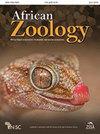坦桑尼亚北部塞伦盖蒂生态系统中被道路杀死的野生动物的数量、模式和组成
IF 0.5
4区 生物学
Q4 ZOOLOGY
引用次数: 4
摘要
在全球范围内,与穿越保护区的道路相关的交通是对野生动物造成许多负面影响的原因,例如在塞伦盖蒂生态系统内发生的野生动物被公路撞死。2015年,在2015年3月至8月的旱季和雨季期间,研究人员对塞伦盖蒂生态系统中长达200公里的砾石道路网进行了连续5天的调查,以记录野生动物道路死亡的数量、模式和组成。共发现野生动物道路死亡51例,包括26种野生动物,其中鸟类18种,哺乳动物8种。鸟类(60.8%)比哺乳动物(39.2%)更容易被杀死。此外,野生动物的道路死亡发生率在上午(56.9%)高于下午(43.1%),哺乳动物(51.7%)高于鸟类(48.3%)。道路条件较好的路段(69.4%)比道路条件较差的路段(30.6%)更宽(80 ~ 80米),交通流量更大。总体而言,角兔(Lepus capensis)是哺乳动物中最常被杀死的物种(17.6%),而鸟类中最常被杀死的物种是头几内亚鸡(Numida meleagris)(13.7%)。为了减少道路死亡事故的数量,我们建议通过安装由图片标志组成的野生动物警告标志来改变司机的超速行为,因为它们已被证明比基于文字的标志更有效地降低速度,从而减少碰撞。此外,负责的管理部门应该对司机进行安全驾驶和法律法规执行方面的教育。此外,应提供重点关注野生动物道路死亡的政策简报,以帮助决策者和工程师改进保护区的道路设计。本文章由计算机程序翻译,如有差异,请以英文原文为准。
Magnitude, Patterns and Composition of Wildlife Roadkill in the Serengeti Ecosystem, Northern Tanzania
Globally, traffic associated with roads that pass through protected areas are the cause of many negative impacts on wildlife, such as wildlife roadkill, which has occurred within the Serengeti ecosystem. A 200 km stretch of gravel road networks that passes through the Serengeti ecosystem was surveyed in 2015 for five consecutive days during each study period during the wet and dry seasons, between March and August 2015, to document the magnitude, patterns and composition of wildlife roadkill. We found a total of 51 wildlife roadkills that consisted of 26 species of wild animals and included 18 bird and 8 mammal species. Bird species (60.8%) were more frequently killed than mammal species (39.2%). Moreover, a higher incidence of wildlife roadkill was recorded in the morning (56.9%) than in the afternoon (43.1%) and more mammals (51.7%) than birds (48.3%) were recorded in the morning. Greater numbers of wildlife roadkill were recorded along road segments with good road conditions (69.4%) that were wider (>8 m) and with higher traffic volumes than along roads with poor conditions (30.6%). Overall, the Cape hare (Lepus capensis) was the most frequently killed species (17.6%) among the mammals, whereas the helmeted guineafowl (Numida meleagris) (13.7%) was most frequently killed among the avifauna. To reduce the number of roadkill incidents, we recommend changing driver speeding behaviours by installing wildlife-warning signage that consists of picture-based signs, because they have been proved to be more effective than word-based signs to reduce speeds and hence, reduce collisions. Additionally, the responsible management authorities should provide education to drivers on safe driving and enforcement of laws and regulations. Further, policy briefings that focus on wildlife roadkill should be made available to assist decision-makers and engineers to improve road design in protected areas.
求助全文
通过发布文献求助,成功后即可免费获取论文全文。
去求助
来源期刊

African Zoology
生物-动物学
CiteScore
2.60
自引率
9.10%
发文量
18
审稿时长
>12 weeks
期刊介绍:
African Zoology , a peer-reviewed research journal, publishes original scientific contributions and critical reviews that focus principally on African fauna in terrestrial, freshwater, and marine ecosystems. Research from other regions that advances practical and theoretical aspects of zoology will be considered. Rigorous question-driven research in all aspects of zoology will take precedence over descriptive research. The Journal publishes full-length papers, critical reviews, short communications, letters to the editors as well as book reviews. Contributions based on purely observational, descriptive or anecdotal data will not be considered.
The Journal is produced by NISC in association with the Zoological Society of South Africa (ZSSA). Acceptance of papers is the responsibility of the Editors-in-Chief in consultation with the Editors and members of the Editorial Advisory Board. All views expressed are those of the author and not necessarily those of the Editors or the Department.
 求助内容:
求助内容: 应助结果提醒方式:
应助结果提醒方式:


